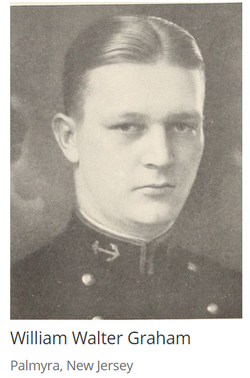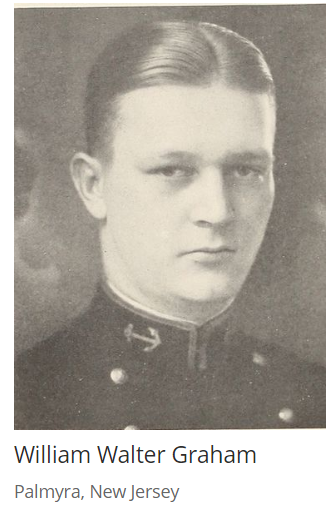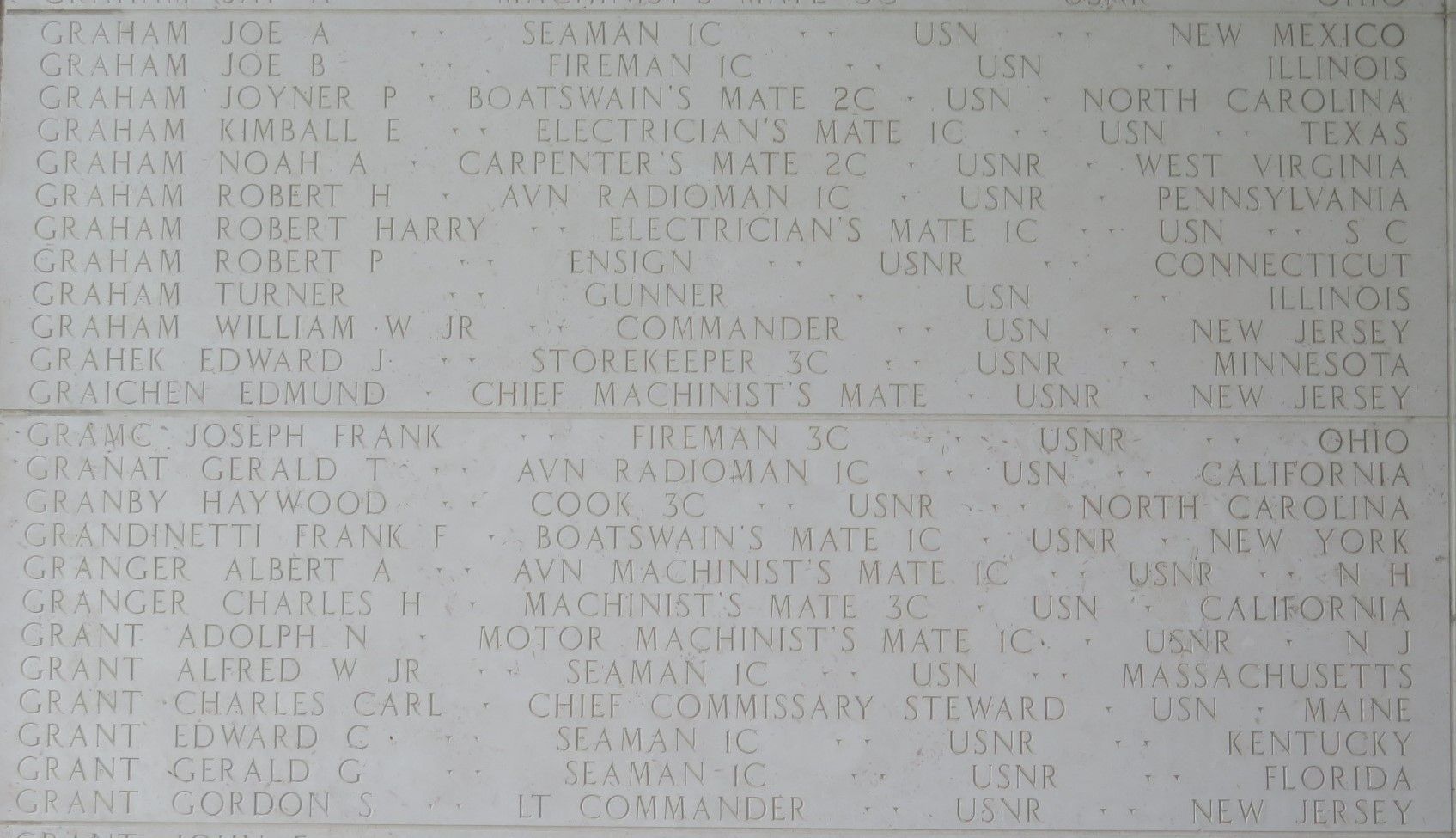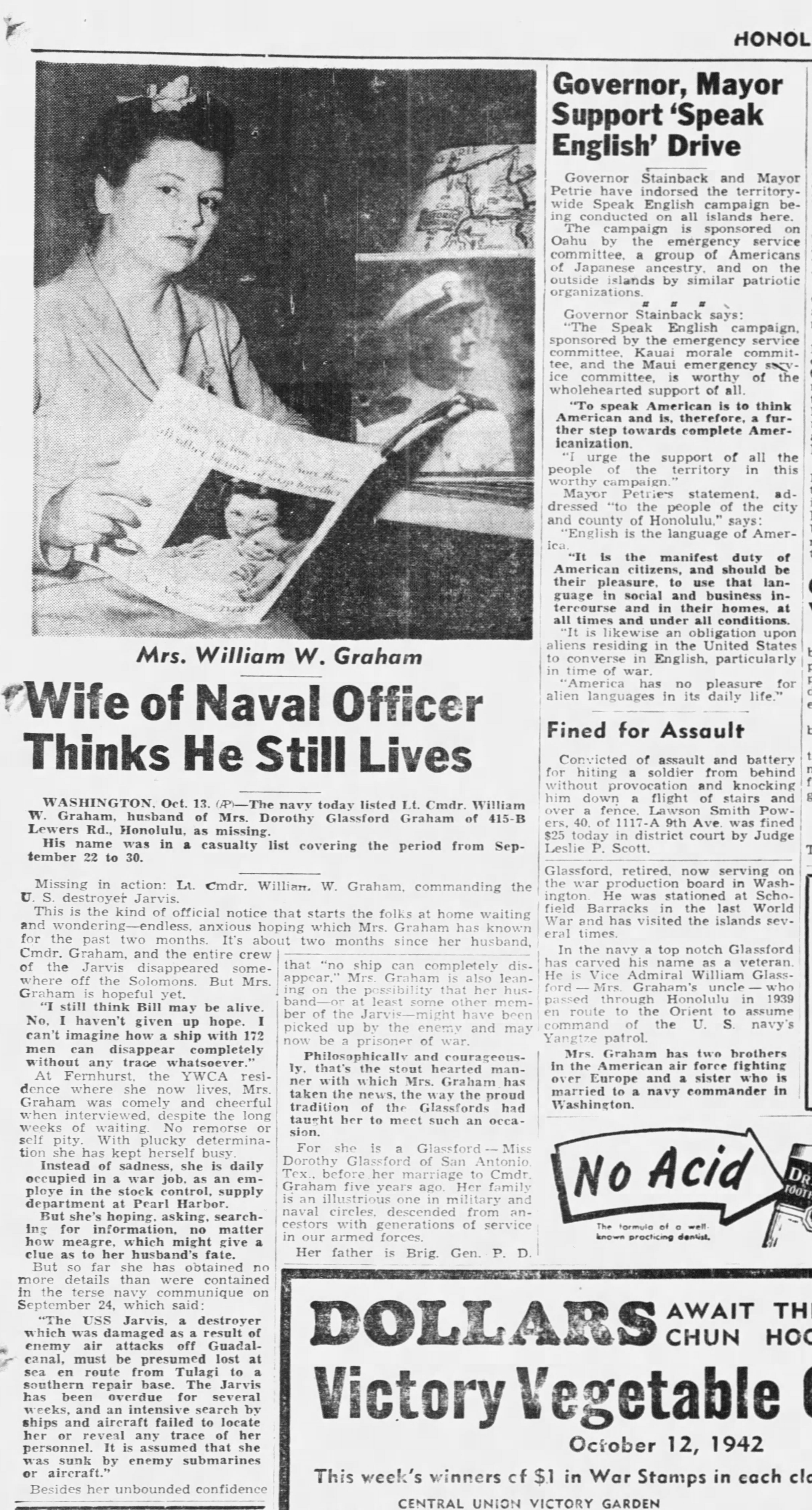Commander William W. Graham Jr. MIA/KIA , missing, date of loss August 9, 1942
later declared dead, dd July 12, 1945
Graduated USNA, Class of 1925
Hometown: New Jersey
Wife, Mrs. Dorothy Glassford Graham, San Antonio, Texas
Ship: Commanding Officer of U.S.S. Jarvis (DD-393)
Service # 0-059610
Awards: Purple Heart
Biography
William graduated from Palmyra high school in 1921. His wife was the former Dorothy Glassford, daughter of Brigadier General Pelham Glassford. William's father was a tea and coffee merchant. He died the day before the Pearl Harbor attack. His mother was Emily, and his brothers were George and Dr. Richard Graham of Point Pleasant.
U.S.S. Jarvis (DD-393)
Mission: Patrol Duty
Mission Date: 9-Aug-42
Location: off Guadalcanal
Cause: Sunk by enemy air attack
Crew: of 233 MIA/KIA
USS Jarvis (DD-393), was a Bagley-class destroyer and the second of three United States Navy ships to be named after James C. Jarvis, a U.S. Navy midshipman who was killed at the age of 13 during the Quasi-War with France.
Guadalcanal campaign
Sailing from Sydney on 14 July, Jarvis arrived in Wellington, New Zealand, on 19 July to join Task Force 62. The task force sailed on 22 July for the Solomons. After conducting rehearsal landings in the Fiji Islands from 28 to 30 July, the invasion force of 84 ships and 20,000 Marines steamed for Guadalcanal on 31 July. Protected from Japanese search planes by rain and heavy mist, the force arrived off the landing beaches at dawn on 7 August.
Following naval and air bombardment of enemy defenses, the first amphibious operation of the war commenced at 0650. Jarvis patrolled as part of the protective screen while Marines established a beachhead. As landing operations progressed, the Allied forces expected the Japanese to strike at the transports with land-based aircraft. However, during the two attacks that occurred that afternoon, the American ships sustained only minor damage and claimed to have destroyed 14 attacking aircraft.
Following a night patrol off the southern end of Savo Island, Jarvis returned to Lunga Point to screen the unloading transports. The warning of an impending air attack suspended these operations and the transports and their protective screen deployed in the body of water between Guadalcanal and Florida Island, soon to be called "Iron bottom Sound". When enemy torpedo bombers appeared around noon on 8 August, they met by heavy anti-aircraft fire. Only 9 of the 26 planes penetrated the defensive fire, but they set the attack transport George F. Elliott on fire and torpedoed Jarvis as she maneuvered between the heavy cruiser Vincennes. Although anti-aircraft fire destroyed the aircraft, its torpedo exploded against Jarvis' starboard side near the forward fireroom, stopping her dead in the water and killing 14 crewmen. Her crew jettisoned the port torpedoes and brought the fires under control. The destroyer Dewey towed her to shallow anchorage off Lunga Point and after the attack, she crossed to Tulagi, where she transferred her seven wounded and conducted temporary repairs.
The Japanese, still mistaking Jarvis for an escaping cruiser, dispatched 31 planes from Rabaul to search out and destroy her. Once discovered, the badly damaged destroyer was no match for bombers raking the ship with bullets and torpedoes. According to Japanese records, Jarvis "split and sank" at 1300 on 9 August. None of her 233 remaining crew survived.
Jarvis received three battle stars for World War II service.
Commander William W. Graham Jr. MIA/KIA , missing, date of loss August 9, 1942
later declared dead, dd July 12, 1945
Graduated USNA, Class of 1925
Hometown: New Jersey
Wife, Mrs. Dorothy Glassford Graham, San Antonio, Texas
Ship: Commanding Officer of U.S.S. Jarvis (DD-393)
Service # 0-059610
Awards: Purple Heart
Biography
William graduated from Palmyra high school in 1921. His wife was the former Dorothy Glassford, daughter of Brigadier General Pelham Glassford. William's father was a tea and coffee merchant. He died the day before the Pearl Harbor attack. His mother was Emily, and his brothers were George and Dr. Richard Graham of Point Pleasant.
U.S.S. Jarvis (DD-393)
Mission: Patrol Duty
Mission Date: 9-Aug-42
Location: off Guadalcanal
Cause: Sunk by enemy air attack
Crew: of 233 MIA/KIA
USS Jarvis (DD-393), was a Bagley-class destroyer and the second of three United States Navy ships to be named after James C. Jarvis, a U.S. Navy midshipman who was killed at the age of 13 during the Quasi-War with France.
Guadalcanal campaign
Sailing from Sydney on 14 July, Jarvis arrived in Wellington, New Zealand, on 19 July to join Task Force 62. The task force sailed on 22 July for the Solomons. After conducting rehearsal landings in the Fiji Islands from 28 to 30 July, the invasion force of 84 ships and 20,000 Marines steamed for Guadalcanal on 31 July. Protected from Japanese search planes by rain and heavy mist, the force arrived off the landing beaches at dawn on 7 August.
Following naval and air bombardment of enemy defenses, the first amphibious operation of the war commenced at 0650. Jarvis patrolled as part of the protective screen while Marines established a beachhead. As landing operations progressed, the Allied forces expected the Japanese to strike at the transports with land-based aircraft. However, during the two attacks that occurred that afternoon, the American ships sustained only minor damage and claimed to have destroyed 14 attacking aircraft.
Following a night patrol off the southern end of Savo Island, Jarvis returned to Lunga Point to screen the unloading transports. The warning of an impending air attack suspended these operations and the transports and their protective screen deployed in the body of water between Guadalcanal and Florida Island, soon to be called "Iron bottom Sound". When enemy torpedo bombers appeared around noon on 8 August, they met by heavy anti-aircraft fire. Only 9 of the 26 planes penetrated the defensive fire, but they set the attack transport George F. Elliott on fire and torpedoed Jarvis as she maneuvered between the heavy cruiser Vincennes. Although anti-aircraft fire destroyed the aircraft, its torpedo exploded against Jarvis' starboard side near the forward fireroom, stopping her dead in the water and killing 14 crewmen. Her crew jettisoned the port torpedoes and brought the fires under control. The destroyer Dewey towed her to shallow anchorage off Lunga Point and after the attack, she crossed to Tulagi, where she transferred her seven wounded and conducted temporary repairs.
The Japanese, still mistaking Jarvis for an escaping cruiser, dispatched 31 planes from Rabaul to search out and destroy her. Once discovered, the badly damaged destroyer was no match for bombers raking the ship with bullets and torpedoes. According to Japanese records, Jarvis "split and sank" at 1300 on 9 August. None of her 233 remaining crew survived.
Jarvis received three battle stars for World War II service.
Gravesite Details
Entered the service from New Jersey.
Family Members
Sponsored by Ancestry
Advertisement
Advertisement







